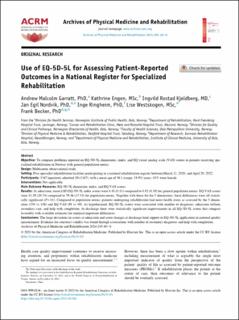Use of EQ-5D-5L for Assessing Patient-Reported Outcomes in a National Register for Specialized Rehabilitation
Garratt, Andrew; Engen, Kathrine; Kjeldberg, Ingvild; Nordvik, Jan Egil; Ringheim, Inge; Westskogen, Lise; Becker, Frank
Peer reviewed, Journal article
Published version
Permanent lenke
https://hdl.handle.net/11250/3109992Utgivelsesdato
2023Metadata
Vis full innførselSamlinger
Originalversjon
Archives of Physical Medicine and Rehabilitation. 2023, 105 (1), 40-48. 10.1016/j.apmr.2023.04.026Sammendrag
Objective: To compare problems reported on EQ-5D-5L dimensions, index, and EQ visual analog scale (VAS) scores in patients receiving spe-
cialized rehabilitation in Norway with general population norms.
Design: Multicenter observational study.
Setting: Five specialist rehabilitation facilities participating in a national rehabilitation register between March 11, 2020, and April 20, 2022.
Participants: 1167 inpatients admitted (N=1167), with a mean age of 56.1 (range, 18-91) years; 43% were female.
Interventions: Not applicable.
Main Outcome Measures: EQ-5D-5L dimension, index, and EQ VAS scores.
Results: At admission, mean§SD EQ-5D-5L index scores were 0.48 (0.31) compared to 0.82 (0.19) for general population norms. EQ VAS scores
were 51.29 (20.74) compared to 79.46 (17.53) for population norms. Together with those for the 5 dimensions, these differences were all statisti-
cally significant (P<.01). Compared to population norms, patients undergoing rehabilitation had more health states as assessed by the 5 dimen-
sions (550 vs 156) and EQ VAS (98 vs 49). As hypothesized, EQ-5D-5L scores were associated with number of diagnoses, admission to/from
secondary care, and help with completion. At discharge there were statistically significant improvements in all EQ-5D-5L scores that compare
favorably with available estimates for minimal important differences.
Conclusions: The large deviations in scores at admission and score changes at discharge lend support to EQ-5D-5L application in national quality
measurement. Evidence for construct validity was found through associations with number of secondary diagnoses and help with completion.

